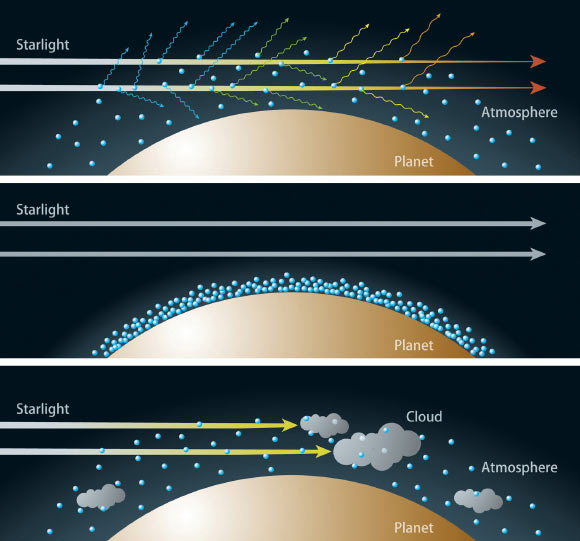Hot-Jupiter Exoplanet WASP-79b Has Yellow Skies | Astronomy – Sci-News.com
Using data from the NASA/ESA Hubble Space Telescope, NASA’s Spitzer Space Telescope, and Magellan II Telescope at Las Campanas Observator in Chile, astronomers have found that the atmosphere of the inflated hot Jupiter WASP-79b is almost transparent to blue light, leaving it with a yellow-tinged sky.

An artist’s illustration of WASP-79b. Image credit: NASA / ESA / L. Hustak, Space Telescope Science Institute.
“We’re really not sure what’s going on here,” said Johns Hopkins University Applied Physics Laboratory planetary scientist Kristin Showalter Sotzen.
“But if similar features are found on other such worlds, it’s going to provoke questions about current theories on atmospheric processes and evolution.”
Hot Jupiters are gas giants with orbital periods less than 10 days. The short period means that these planets are very close to their parent stars.
WASP-79b is a hot Jupiter with a mass 0.9 times that of Jupiter and an orbital period of 3.66 days.
The planet orbits WASP-79, an F-type star located some 780 light-years away in the constellation of Eridanus.
WASP-79b is in an unusual polar orbit about the host star, which goes against scientists’ theories about how planets form.
It has an extended atmosphere, which is ideal for studying starlight that is filtered through and grazes the atmosphere on its way toward Earth.
“We’re trying to look at a lot of different hot Jupiters because they’re easier to analyze,” Sotzen said.
“What we learn from them will help us make predictions about the atmospheres of other exoplanets, like whether they have clouds or not.”
“That information could in turn help determine a planet’s habitability. If you have a haze around a planet, for example, it could provide a cooling or warming effect for a planet that’s maybe on the edge of the habitable zone.”

An artist’s schematic relating an exoplanet’s atmosphere to the visible light that passes through. Cloudless, distended atmospheres (top) scatter mostly blue light through Rayleigh scattering, while longer wavelengths like red light pass through. Cloudy atmospheres (bottom) equally prevent all wavelengths of visible light from transmitting. If the atmosphere is less extended and cloudless (middle), all visible light passes through about equally. Image credit: National Astronomical Observatory of Japan.
To study WASP-79b, Sotzen and colleagues used data from Hubble’s Wide Field Camera 3, Magellan/Low Dispersion Survey Spectrograph, and Spitzer.
They expected to see a decrease in the amount of blue starlight due to an atmospheric phenomenon called Rayleigh scattering. Instead, they saw the opposite trend.
This result was consistent among independent observations of WASP-79b made with NASA’s Transiting Exoplanet Survey Satellite.
“This is a strong indication of an unknown atmospheric process that we’re just not accounting for in our physical models,” Sotzen said.
“I’ve shown the WASP-79b spectrum to a number of colleagues, and their consensus is ‘that’s weird’.”
The researchers would like to find other planets with a similar condition to learn more.
“Because this is the first time we’ve see this, we’re really not sure what the cause is,” Sotzen said.
“We need to keep an eye out for other planets like this because it could be indicative of unknown atmospheric processes that we don’t currently understand.”
“Because we only have one planet as an example, we don’t know if it’s an atmospheric phenomenon linked to the evolution of the planet.”
The findings were published in the Astronomical Journal.
_____
Kristin S. Sotzen et al. 2020. Transmission Spectroscopy of WASP-79b from 0.6 to 5.0 μm. AJ 159, 5; doi: 10.3847/1538-3881/ab5442






